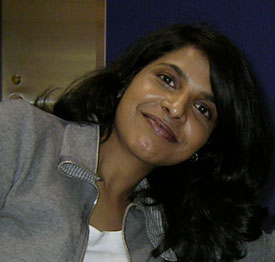By Karthika Swamy Cohen
Biological aggregations such as bird flocks, fish schools, and insect swarms exhibit collective motion.
The study of collective movement is important not only to better understand how these animal groups consume resources, transmit disease, and impact evolution, but also enables applications in computer algorithms, robotic self-assembly, and the like.
At a minisymposium talk titled “Topological Data Analysis of Biological Aggregation Dynamics” at the SIAM Annual Meeting, Chad Topaz of Williams College described the application of topological analysis to study such biological aggregations.
Biological aggregations abound in nature
“Think about moving towards topological reductions of complex systems,” Topaz said and went on to explain the three questions his group tries to answer. The first asks, can you determine individual level behaviors of these aggregations? The second: can you assess macroscopic group properties? And third, how do you elucidate the connection between these? Topaz used the talk to address the second question.
“This is a task suited for a data science approach,” he began. “What are you going to do to make sense of all that data?”
Topaz uses data from a well-known model of collective motion rather than from experimental data. The model proposed by Vicsek et al. in 1995 is a dynamical system that illustrates the movement of agents that interact via alignment, attraction, and/or repulsion. Systems such as cells, bacteria, insects, fish, and birds have been described with Vicsek-like models. The model describes an ensemble of self-driven particles and posits that at each time step, each particle's heading is determined by interactions with neighbors, subject to noise.
Topaz’s group runs a simulation on this model. Choosing a certain order parameter, they study its time series, and assess the dynamics via the time series. The idea is to use topology as the order parameter to look at aggregation through a topological lens, Topaz explained.
Using time series of the particles' positions and headings, Topaz’s group assigns a topological signature to the evolving ensemble, thus identifying dynamical events that traditional methods do not.
For this, data is envisioned as a point cloud. Each simulation time frame represents a point cloud in position-velocity space. Topaz analyzes the topological structure of these point clouds. The team then builds a solid object out of that data, and determines its topology.
Quantifying group dynamics, as bacteria moving in a thin layer of fluids (depicted on the left) is a task suited for data science.
Topology of the data is measured by calculating Betti numbers. While Betti numbers don't tell you everything about the topology of the object, they provide a lot of useful information, Topaz explained.
“I want to make the argument that this is a big data problem and I solved it by counting 18 points,” Topaz said, emphasizing the benefits of using topological analysis to study aggregations.
The persistent homology is interpreted by calculating the first few Betti numbers. Homology is an algebraic topological tool that measures and distinguishes between features of topological space, such as, spheres, discs, annulus etc. Persistent homology measures homology of data by creating connections between proximate data points, varying the scale over which such connections are made, and determining persistent features across scales.
Topaz introduces a visualization that displays Betti numbers over simulation time and topological persistence scale. The topological results are compared to order parameters typically used to quantify the global behavior of aggregations, such as polarization and angular momentum. The homological measures in Topaz’s analysis distinguish simulations that the usual alignment order parameter cannot, revealing events and structure that order parameters are unable to capture.
Topaz thus gave insights on how topological signatures may be used to select between models of experimental aggregation data.
Persistent homology has been widely used to uncover the topological structure of data in various fields, such as neuroscience, language processing, signal analysis, bioinformatics, and computer vision.
 |
Karthika Swamy Cohen is the managing editor ofSIAM News. |